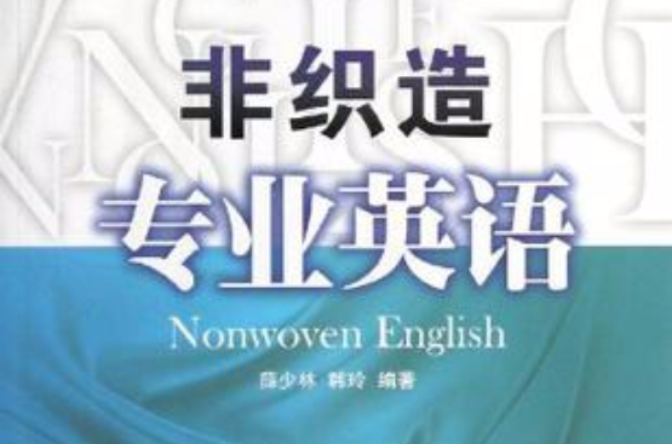《非織造專業英語》是2013年出版的圖書,作者是薛少林。
基本介紹
- 書名:非織造專業英語
- 作者:薛少林
- ISBN:9787566901958
- 頁數:211
- 定價:34.00元
- 出版時間:2013-1
內容簡介,作品目錄,
內容簡介
《非織造專業英語(紡織服裝高等教育十二五部委級規劃教材)》(作者薛少林、韓玲)涉及非織造材料與工程專業的相關知識,內容包括非織造布的概述、纖維原料、非織造布成網、固網、整理、產品、測試及新技術八個部分,每小節後附有生詞表、注釋,最後附有總辭彙表。
《非織造專業英語(紡織服裝高等教育十二五部委級規劃教材)》是為非織造材料與工程專業本(專)科學生提供的專業英語教材,也可作為紡織工程等相關專業的“非織造布概論”課程的雙語課教材,亦可供從事非織造材料與工程相關工作的人員參考使用。
作品目錄
CHAPTER1
GENERALINTRODUCTION
1.1 DEFINITION OF NONWOVENS
1.1.1 Definition of INDA
1.1.2 Definition of EDANA
1.1.3 Definition of ASTM
1.2 CLASSIFICATION OF NONWOVENS
1.3 DEVELOPMENT OF NONWOVENS
1.3.1 History and Background
1.3.2 Trends in Materials, Process and New Products
CHAPTER 2
FIBERS FOR NONWOVENS
2.1 INTRODUCTION
2.2 CELLULIC NATURAL FIBERS
2.2.1 Cotton
2.2.2 Flax
2.2.3 Hemp
2.2.4 Jute
2.2.5 Ramie
2.3 PROTEIN NATURAL FIBERS
2.3.1 Wool
2.3.2 Silk
2.3.3 Camel Hair
2.3.4 Mohair
2.4 REGENERATED FIBERS
2.4.1 Rayon
2.4.2 Cellulose Acetate
2.4.3 Lyocell
2.5 SYNTHETIC FIBERS
2.5.1 Olefin Fiber
2.5.2 Polyester
2.5.3 Nylon Fibers
2.5.4 Acrylic
2.5.5 Carbon Fibers
CHAPTER 3 WEB FORMATION TECHNOLOGIES
OF NONWOVENS
3.1 DRY LAID PROCESS
3.1.1 Fiber Selection
3.1.2 Fiber Preparation
3.1.3 Web Forming
3.1.4 Laying
3.2 WETLAID PROCESS
3.2.1 Paper and Textiles
3.2.2 Raw Materials
3.2.3 Production Machinery
3.2.4 Special Features of the Wetlaid Process and Its Products
3.3 SPUNLAID PROCESS
3.3.1 Polymer
3.3.2 Spinning and Web Formation
3.3.3 Characteristics and Properties
3.3.4 Applications
3.4 MELT BLOWN PROCESS
3.4.1 Polymer Type
3.4.2 Processing
3.4.3 Web Characteristics and Properties
3.4.4 Process Structure Property
3.4.5 Applications
3.4.6 Comparison of Melt Blown and Spunbond
CHAPTER 4 WEB BONDING TECHNOLOGIES OF
NONWOVENS
4.1 CHEMICAL BONDING PROCESS
4.1.1 Bonding Agents (Binders)
4.1.2 Chemical Bonding Processes
4.1.3 Applications
4.2 NEEDLEPUNCHING PROCESS
4.2.1 Process
4.2.2 Mechanism of Needle Loom
4.2.3 Felting Needle
4.2.4 Types of Needle Looms
4.2.5 Machine Variable
4.2.6 Applications
4.3 SPUNLACING PROCESS
4.3.1 Process
4.3.2 Materials Used in Spunlaced Technology
4.3.3 Parameter Affecting the Product Performance
4.3.4 Properties of Spunlaced Fabrics
4.3.5 Applications
4.4 THERMAL BONDING PROCESS
4.4.1 Binders
4.4.2 Methods of Thermal Bonding
4.4.3 Advantages and Energy Comparison
4.5 STITCH BONDING PROCESS
4.5.1 Batt Bonded by Threads
4.5.2 Stitch Bonding Without Threads
CHAPTER5
NONWOVENS FINISHING
5.1 INTRODUCF1ON
5.2 SURFACE FINISHING
5.2.1 Calendering
5.2.2 Embossing
5.2.3 Pressing
5.2.4 Singeing, Splitting, Grinding and Velouring
5.3 SHAPE FINSHING
5.3.1 Shrinkage
5.3.2 Wrenching
5.3.3 Creeping, Perforating and Slitting
5.4 WET FINISHING
5.4.1 Washing
5.4.2 Dyeing
5.4.3 Printing
5.5 CHEMICAL FINISHES
5.5.1 Antistats
5.5.2 Antimicrobials
5.5.3 Water Repellents
5.5.4 Lubricants
5.5.5 UV Absorbers and Polymer Stabilizers
5.5.6 Flame Retardants
5.5.7 Softeners
5.5.8 Absorbency and Rewetters
5.5.9 Thermoplastic Binders, Resins and Emulsion Polymers
5.5.10 Thermosetting Resins and Crosslinking Agents
5.5.11 Soil Release
5.5.12 Optical Brighteners
5.6 COATING
5.6.1 Chemical Vapour Deposition and Physical vapour Deposition
5.6.2 Electro Deposition
5.6.3 Spray Coating
5.7 LAMINATING AND FLOCKING
CHAPTER 6 PRODUCTS AND APPLICATIONS OF
NONWOVENS
6.1 HEATHCARE AND HYGIENE
6.1.1 Absorbent Hygiene Products
6.1.2 Healthcare and Medical Application
6.2 INDUSTRIAL APPLICATIONS
6.2.1 Automotive
6.2.2 Building
6.2.3 Cable Wrapping
6.2.4 Filtration
6.2.5 Industrial and Institutional Wipes
6.3 PACKAGING AND AGRICULTURE
6.3.1 Packaging
6.3.2 Agriculture and Horticulture
6.3.3 Landscaping Fabric
6.4 GEOTEXTILE
6.4.1 Geotextile Classifications
6.4.2 Geotextile Types
6.4.3 Essential Functions of Geotextiles
5.5 FURNISHINGS
6.6 NONWOVENS IN APPAREL INDUSTRY
6.6.1 Protective Dress
6.6.2 Fashion Apparel
CHAPTER 7 NONWOVENS TESTING
7.1 NONWOVENS CHARACTERIZATIONS
7.2 IESTING STANDARDS
7.3 IESTING CLASSIFICATION AND BASIC TESTS ITEMS
7.4 IESTING METHODS AND TECHNIQUE
7.4.1 Absorbencycapacity Tests
7.4.2 Electrostatic Properties
7.4.3 Flammability and Optical Properties
7.4.4 Permeability and Porosity
7.4.5 Filtration
7.4.6 Strength
7.4.7 Softness
7.4.8 Barrier
7.4.9 Contamination
CHAPTER 8 NEW TECHNOLOGIES FOR NONWOVENS
8.1 NEW PRODUCTS FROM BIOCOMPONENTS
8.2 NANOFIBER NONWOVENS
8.2.1 Electrospinning Process
8.2.2 Properties of Nanofibers
8.2.3 Applications of Nanofibers
8.2.4 Challenges in Nanofibers
8.3 GREEN OR ENVIRONMENTFRIENDLY NONWOVENS
8.4 SMART TEXTILES
8.4.1 Definition of Intelligent Clothing
8.4.2 Nonwoven Confortable Fabrics with Electric Circuits
8.4.3 Stretchable Nonwovens
辭彙總表

